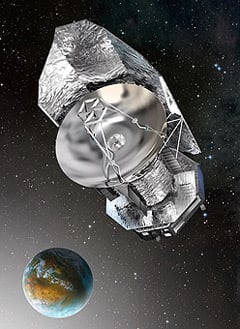This article is more than 1 year old
Euro space 'scopes go for 14 May launch
Herschel and Planck set to probe universe
The European Space Agency's Herschel and Planck space telescopes are set to blast off on 14 May atop an Ariane 5 ECA launcher from French Guiana, the agency reports.
The 'scopes are destined for "L2", the second Lagrangian point of the Sun-Earth system lying around 1.5m km from Earth. ESA explains that this is one of five locations discovered by Joseph Louis Lagrange "where all the gravitational forces acting between two objects cancel each other out and therefore can be used by spacecraft to 'hover'".
Described as a "great place from which to observe the larger universe", L2 provides a "stable viewpoint" free from the need to orbit the Earth, and therefore pass through its shadow, as well as lying beyond the reach of our planet's radiated heat.
 The latter will prove important in the case of Herschel (see pic), the largest infrared telescope ever put into space and boasting a 3.5 m diameter primary mirror.
The latter will prove important in the case of Herschel (see pic), the largest infrared telescope ever put into space and boasting a 3.5 m diameter primary mirror.
Herschel will for the first time probe the "entire range from far-infrared to sub-millimetre wavelengths and bridge the two", enabling scientists to study "otherwise invisible dusty and cold regions of the cosmos, both near and far".
To do this, the 3.4 tonne Herschel is carrying a high-resolution spectrometer dubbed the Heterodyne Instrument for the Far Infrared (HIFI) plus a pair of cameras/imaging spectrometers: the Photoconductor Array Camera and Spectrometer (PACS) and the Spectral and Photometric Imaging REceiver (SPIRE). The instruments (further details here) are cooled to near ablsolute zero by a helium cryogenic system, and powered by around 12m2 of solar arrays.
The spacecraft's main objective during its slated three-and-a-half year mission is to discover "how the first galaxies formed and how they evolved to give rise to present day galaxies like our own". Scientists also hope it will give insights into "clouds of gas and dust where new stars are being born, disks out of which planets may form and cometary atmospheres packed with complex organic molecules".
 Planck, meanwhile, is tasked with studying the Cosmic Microwave Background "with the highest accuracy ever achieved".
Planck, meanwhile, is tasked with studying the Cosmic Microwave Background "with the highest accuracy ever achieved".
The 1.9 tonne vessel's instrument payload consists of telescope and twin radio detector arrays. The 'scope uses an "off-axis tilted Gregorian system" with a primary 1.9 × 1.5 m, mirror (effective aperture 1.5m) to feed the Low Frequency Instrument (LFI) detector tuned to the 27 to 77 GHz frequency range and the High Frequency Instrument operating in the 84 GHz to 1 THz range (more details here).
ESA summarises: "These receivers will determine the black body equivalent temperature of the background radiation and will be capable of distinguishing temperature variations of about one microkelvin. These measurements will be used to produce the best ever maps of anisotropies [small fluctuations in the temperature across the sky] in the CMB radiation field."
Planck has a nominal life of 15 months following its "Calibration and Performance Verification Phase". It will arrive at L2 around six weeks after launch, while Herschel - travelling independently - is expected to reach its destination after roughly 100 days. ®
